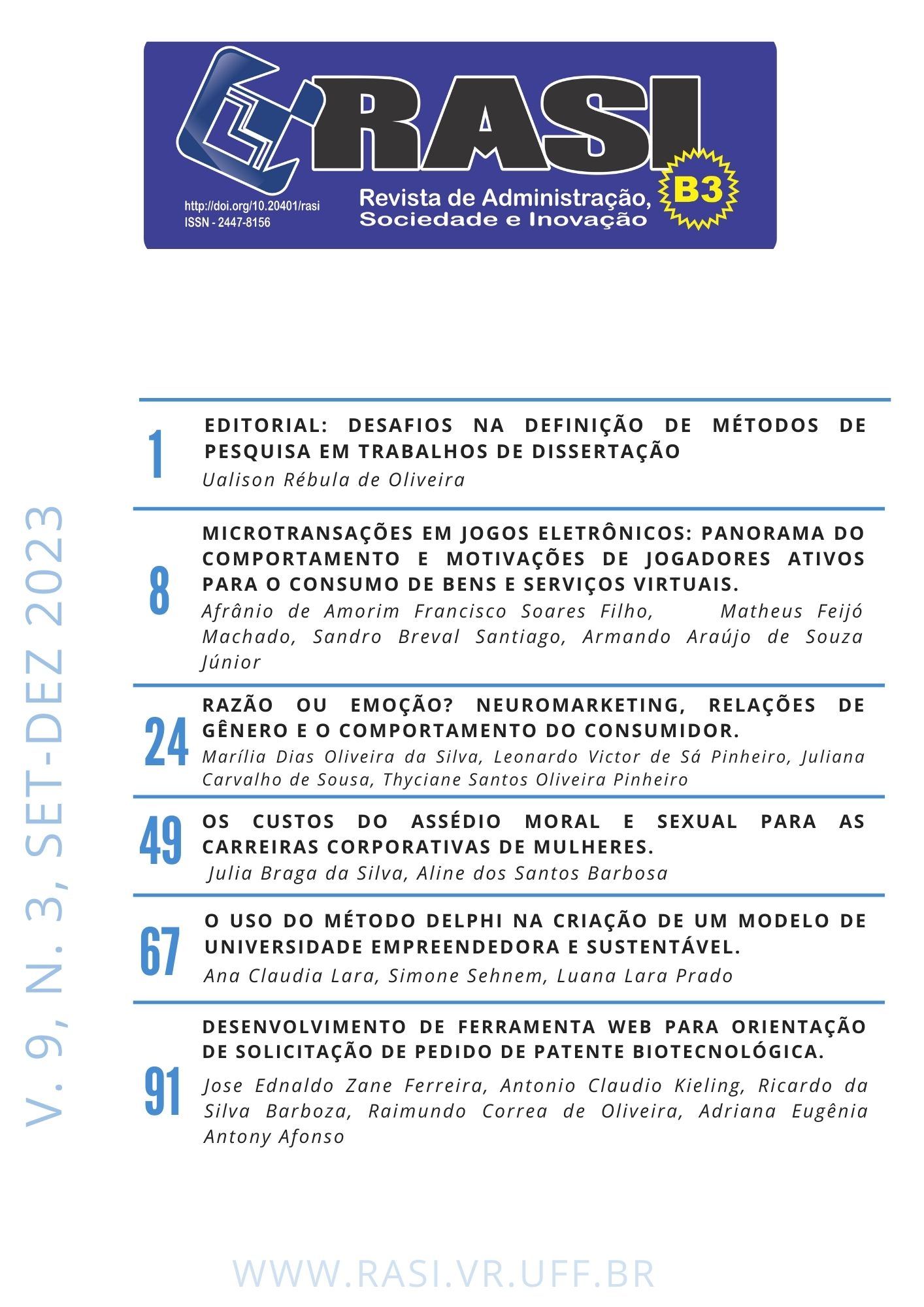The Costs of Sexual and Moral Harassment for Women's Corporate Careers
DOI:
https://doi.org/10.20401/rasi.9.3.736Keywords:
Assédio Moral, Assédio Sexual, Gestão de Pessoas, Equidade de Gênero, Carreira FemininaAbstract
Historically, the division of labor was structured according to the power relations established between genders, attributing reproductive areas to women and productive areas to men. The insertion of women in roles generally belonging to men re-signifies the power relationship and opens precedents for oppressive interactions. In this context, this research aims to identify what are the interferences faced by women in the rise in their careers after suffering moral or sexual harassment. To achieve this goal, we interviewed 12 women who have been victims of moral and/or sexual harassment during their corporate careers. As main results, we highlight that layoffs, resignation requests, changes of areas, changes of position, lawsuits and the consideration of reducing positions and salaries were the main interferences faced by these women during their trajectories. In addition, through the reports, it was possible to identify abusive behaviors and the distribution of positions in the organizational hierarchical structures as common points in the profile of the harassers.
Downloads
References
Abreu, H., & Gardinali, M. (2016). O assédio sexual como obstáculo à igualdade material de gênero. Brasília: Revista Omnes – ANPR.
Anwar, S. M., & Burfat, F. M. (2021). The Effects of Harassment of Working Women at Male Dominated Workplace. Pakistan Journal of Social Sciences (PJSS), 41(1).
Babic, A., & Hansez, I. (2021). The glass ceiling for women managers: antecedents and consequences for work-family interface and well-being at work. Frontiers in psychology, 12, 618250.
Barbosa, A. D. S., Romani-Dias, M., & Veludo-de-Oliveira, T. M. (2020). As Facetas da Comodificação de Mulheres: Violência no Contexto Universitário de Administração. Revista de Administração Contemporânea, 24(6), 582-599.
Barreto, M. M. S. (2005). Assédio moral: a violência sutil-análise epidemiológica e psicossocial no trabalho no Brasil. Doctoral dissertation - Pontifícia Universidade Católica de São Paulo.
Beauvoir, S. (1970). O segundo sexo. Sérgio Milliet, 4ª edição. São Paulo: Difusão Europeia do livro, vols. I e II.
Bourdieu, P. (2010). A dominação masculina. (Trad. Maria Helena Kühner). Rio de Janeiro: Bertrand Brasil.
Cárdenas, M. C., Eagly, A. H., Salgado, E., Goode, W., Heller, L. I., Jaúregui, K., ... Tunqui, R. C. (2014). Latin American female business executives: An interesting surprise. Gender in Management, 29(1), 2-24. 10.1108/GM-06-2013-0067.
Corrêa, A. M. H., & Carrieri, A. D. P. (2007). Percurso semântico do assédio moral na trajetória profissional de mulheres gerentes. Revista de Administração de Empresas, 47, 22-32.
Creswell, J. (2007). Projeto de pesquisa: métodos qualitativo, quantitativo e mistos.
Tradução de Luciana Oliveira da Rocha. Porto Alegre: Artmed. Bookman.
Dias, I. (2008). Violência Contra as Mulheres no Trabalho. O caso do assédio sexual.
Sociologia, Problemas e Práticas, 57, 11-23.
Diniz, A. P. R., Silva, A. D., & Menezes, R. S. S. (2011). Entre “Maria” e “Eva”: as representações sociais de executivas sobre a profissão. In: XXXV Encontro Nacional da Anpad, Rio de Janeiro
Dutra, J. S. (1996). Administração de carreiras: uma proposta para repensar a gestão de pessoas. São Paulo: Atlas.
Feldblum, C. R., & Lipnic, V. A. (2016). Select task force on the study of harassment in the workplace. Washington: US Equal Employment Opportunity Commission.
Fernandes, M. N. De F., Brito, E. S., Silva, A. G., Piccolo, I. B., Souza, J. L., Cunha, L. P., & Makyama, T. S. V. (2019). Assédio, sexismo e desigualdade de gênero no ambiente de trabalho. Revista Eletrônica da Faculdade de Direito de Franca, 14(1), 237-253.
Fernandez, R. M., & Rubineau, B. (2019). Network recruitment and the glass ceiling: Evidence from two firms. RSF: The Russell Sage Foundation Journal of the Social Sciences, 5(3), 88-102.
Ferrari, L., Mari, V., De Santi, G., Parini, S., Capelli, G., Tacconi, G., … & Gumbs, A. (2022). Early barriers to career progression of women in surgery and solutions to improve them: a systematic scoping review. Annals of Surgery, 276(2), 246 – 255.
Figueiredo, M. G., & Diniz, G. R. S. (2018). Mulheres, casamento e carreira: um olhar sob a perspectiva sistêmica feminista. Nova Perspectiva Sistêmica, 27(60), 100 – 119.
Fonseca, J. J. S. (2002). Apostila de metodologia da pesquisa científica. João José Saraiva da Fonseca.
Freitas, M. D. (1996). Assédio sexual: a proposta perversa. RAE Light, 36(3), 4-9.
Freitas, M. E. D. (2001). Assédio moral e assédio sexual: faces do poder perverso nas organizações. Revista de administração de Empresas, 41, 8-19.
Freitas, M. E. D. (2007). Quem paga a conta do assédio moral no trabalho?. RAE eletrônica, 6.
Gil, A. C. (2002). Como elaborar projetos de pesquisa (Vol. 4, p. 175). São Paulo: Atlas. Guerra, R. D. (2011). Mulher e discriminação. Belo Horizonte: Fórum.
Higa, F. D. C. (2016). Assédio sexual no trabalho e discriminação de gênero: duas faces da mesma moeda?. Revista Direito GV, 12, 484–515.
Hirigoyen, M. F. (2002). Mal-estar no trabalho: redefinindo o assédio moral. Bertrand Brasil.
Instituto Brasileiro de Geografia e Estatística. Estatísticas de Gênero: Indicadores sociais das mulheres no Brasil. Rio de Janeiro, 2019. Disponível em
<https://biblioteca.ibge.gov.br/visualizacao/livros/liv101784_informativo.pdf>. Acesos em Acesso em 02 mar 2022.
Johnson, A. (1997). The gender knot: unraveling our patriarchal legacy. Philadelphia, PA: Temple University Press.
Johnson, P. A., Widnall, S. E., Benya, F. F., & Washington, D. C. (2018). Sexual harassment of women. Climate, culture, and consequences in academic sciences, engineering, and medicine. Washington: National Academy of Sciences.
Kanan, L. A. (2010). Poder e liderança de mulheres nas organizações de trabalho.
Organizações & Sociedade, 17(53).
Kergoat, D. (2003). Divisão sexual do trabalho e relações sociais de sexo. Trabalho e cidadania ativa para as mulheres: desafios para as Políticas Públicas, 55–63.
Lewellyn, K. B., & Muller-Kahle, M. I. (2020). The corporate board glass ceiling: The role of empowerment and culture in shaping board gender diversity. Journal of Business Ethics, 165(2), 329-346.
Lima, C. A. P. C., Oliveira Silva, B. C., & Bezerra, J. C. V. (2020). Mulher macho, não senhor! Um estudo de caso sobre a percepção de gestoras e seus pares a respeito do modelo de gestão feminina. Revista de Administração, Sociedade e Inovação, 6(3), 7-21.
McEwen, C., Pullen, A., & Rhodes, C. (2021). Assédio sexual no trabalho: um problema de liderança. Revista de Administração de Empresas, 61.
Miller, T. R., & Lemons, M. A. (1998). Breaking the glass ceiling: lessons from a management pioneer. SAM Advanced Management Journal, 63, 4-9.
Nardes, L., Gallon, S., & Rech, E. (2020). Percepção de Carreiras das Mulheres: As Barreiras no Desenvolvimento da Carreira. Administração de Empresas em Revista, 3(21), 160- 185.
Pimenta, W. (2014). Dupla jornada de trabalho: uma análise da condição feminina no trabalho doméstico. In: VIII Jornadas de Sociología de la Universidad Nacional de La Plata.
Prohaska, A., & Gailey J. (2009). Achieving masculinity through sexual predation: the case of hogging. Texas, EUA: Journal of Gender Studies.
Reis, A. C. G. (2014). Percepção de barreiras na carreira e diversidade de género: Estudo com uma amostra de trabalhadores do sector energético. Doctoral dissertation.
Shaw, E., Hegewisch, A., & Hess, C. (2018). Sexual harassment and assault at work: Understanding the costs. Institute for Women’s Policy Research Publication, IWPR B, 376.
Steil, A. V. (1997). Organizações, gênero e posição hierárquica-compreendendo o fenômeno do teto de vidro. Revista de Administração da Universidade de São Paulo, 32(3).
Thome, C. F. (2012). O princípio da igualdade de gênero e a participação das mulheres nas organizações sindicais de trabalhadores. O princípio da igualdade de gênero e a participação das mulheres nas organizações sindicais de trabalhadores.
United States. Federal Glass Ceiling Commission. (1995). A solid investment: Making full use of the nation's human capital: recommendations of the Federal Glass Ceiling Commission. The Commission. Disponível em < https://ecommons.cornell.edu/bitstream/handle/1813/79349/GlassCeilingRecommendations.p df?sequence=1&isAllowed=y>. Acesso em 18 mar 2022.
Downloads
Published
Issue
Section
License
Copyright (c) 2023 Review of Administration, Society and Innovation

This work is licensed under a Creative Commons Attribution 4.0 International License.
RASI, in accordance with Law No. 9,610 of February 19, 1998, which amends, updates and consolidates Brazilian copyright law and makes other provisions, adopts the following conditions of the Copyright Assignment:
1. RASI maintains, with the transfer of copyrights, the possession of rights over the content published;
2. The author retains his moral rights of the content, including the right to be identified as the author whenever the content is published;
3. Despite the attribution of copyright, the author retains the right to reuse the material in future collections of his own work without encumbrance. The acknowledgments of the previous publication in the RASI are the only requirements in such cases;
4. The author may make photocopies of the content, or distribute it by electronic mail or fax, provided that they are intended for their own classes and for the purpose of meeting research objectives, provided that: (a) such copies are not resold and (b) reference to the original source of the publication and the name of the RASI are clearly indicated on all copies made of the document.











